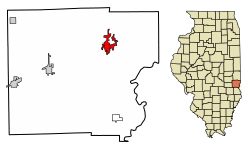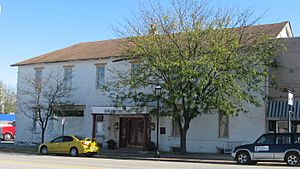Marshall, Illinois facts for kids
Quick facts for kids
Marshall
|
|
|---|---|

Marshall, Illinois Court House
|
|

Location of Marshall in Clark County, Illinois
|
|
| Country | United States |
| State | Illinois |
| County | Clark |
| Founded | 1835 |
| Area | |
| • Total | 3.68 sq mi (9.53 km2) |
| • Land | 3.67 sq mi (9.49 km2) |
| • Water | 0.01 sq mi (0.04 km2) |
| Elevation | 620 ft (190 m) |
| Population
(2020)
|
|
| • Total | 3,947 |
| • Density | 1,076.65/sq mi (415.71/km2) |
| Time zone | UTC-6 (CST) |
| • Summer (DST) | UTC-5 (CDT) |
| ZIP Code(s) |
62441
|
| Area code(s) | 217 |
| FIPS code | 17–47163 |
| GNIS feature ID | 2395021 |
| Wikimedia Commons | Marshall, Illinois |
| Website | City of Marshall, Illinois |
Marshall is a city in Clark County, Illinois, United States. It is also the county seat, which means it's where the main government offices for the county are located. Marshall is about 20 miles west of Terre Haute, Indiana. In 2020, about 3,947 people lived there.
Contents
History of Marshall
Marshall was started in 1835 by a person named William B. Archer. This was eight years after the National Road, an important early American highway, reached the area. The city got its name from John Marshall, who was a very important judge (Chief Justice) of the U.S. Supreme Court. Marshall officially became a city on May 14, 1873.
Marshall During the Civil War
In 1863, during the American Civil War, Marshall had some interesting events. Some local people, known as "Copperheads," were against the war. They tried to help soldiers who had left the Union Army without permission.
In March 1863, a group of soldiers from Indiana came to Marshall and arrested some of these runaway soldiers. However, a local judge named Charles H. Constable ordered the runaway soldiers to be set free. He even ordered the arrest of two Union sergeants, saying they had kidnapped people.
Because of this, about 250 soldiers, led by Colonel Henry B. Carrington, were sent from Indianapolis. They surrounded the courthouse, freed their sergeants, and arrested Judge Constable. However, the judge was later cleared of any wrongdoing after he explained his actions.
The Handy Writers' Colony
From 1950 to 1964, Marshall was home to the Handy Writers' Colony. This was a place where writers could live and work. The most famous writer who stayed there was James Jones, who wrote famous books. He even built a house in Marshall and lived there from about 1952 to 1957.
Geography of Marshall
Marshall covers a total area of about 3.68 square miles (9.53 square kilometers). Most of this area, about 3.67 square miles (9.49 square kilometers), is land. A very small part, about 0.02 square miles (0.04 square kilometers), is water.
Population and People
| Historical population | |||
|---|---|---|---|
| Census | Pop. | %± | |
| 1880 | 1,885 | — | |
| 1890 | 1,900 | 0.8% | |
| 1900 | 2,077 | 9.3% | |
| 1910 | 2,569 | 23.7% | |
| 1920 | 2,222 | −13.5% | |
| 1930 | 2,368 | 6.6% | |
| 1940 | 2,758 | 16.5% | |
| 1950 | 2,960 | 7.3% | |
| 1960 | 3,270 | 10.5% | |
| 1970 | 3,468 | 6.1% | |
| 1980 | 3,379 | −2.6% | |
| 1990 | 3,555 | 5.2% | |
| 2000 | 3,771 | 6.1% | |
| 2010 | 3,933 | 4.3% | |
| 2020 | 3,947 | 0.4% | |
| U.S. Decennial Census | |||


According to the 2020 census, Marshall had 3,947 people living in 1,627 households. Out of these households, 1,129 were families.
Who Lives in Marshall?
- Most people (93.06%) are White.
- A smaller number are African American (0.63%), Native American (0.25%), or Asian (0.89%).
- About 1.49% are from other racial backgrounds, and 3.67% are from two or more races.
- About 3.34% of the population are Hispanic or Latino.
Households and Families
- About 31.8% of households had children under 18 living with them.
- About 43.82% were married couples.
- About 20.34% were households led by a female with no husband present.
- About 23.36% of all households were made up of people living alone.
- About 13.95% of households had someone aged 65 or older living alone.
Age Groups
The people in Marshall are spread across different age groups:
- 21.4% are under 18 years old.
- 8.5% are between 18 and 24 years old.
- 22.1% are between 25 and 44 years old.
- 23.4% are between 45 and 64 years old.
- 24.7% are 65 years or older.
The average age in Marshall is 42.9 years.
Economy and Jobs
The main business area in Marshall is around the county courthouse. A major employer in the town is a company called ZF. They have a factory that makes car electronics, and they employ about a thousand people from the area. Marshall is also home to the Archer House Hotel, which is the oldest hotel in Illinois that has been open continuously.
Arts and Culture
Every autumn, Marshall hosts a fun event called the Fall Festival.
The Marshall post office has a special painting inside called Harvest. It's an oil painting on canvas that was created in 1938 by an artist named Miriam McKinnie. This painting was part of a program in the United States from 1934 to 1943 that helped artists create murals for public buildings.
Notable People from Marshall
Many interesting people have connections to Marshall, Illinois:
- Robert H. Birch: An American outlaw from the old West who grew up in Marshall.
- Ed Carpenter: A professional race car driver in the IndyCar Series. He was raised in Marshall.
- Charles H. Constable: A lawyer, Illinois State Senator, and Judge who was a close friend of Abraham Lincoln. He lived in Marshall.
- Walter E. Cork: An Illinois state representative and businessman who lived in Marshall.
- Gerald Forsythe: A businessman who owns a car racing team (Forsythe Championship Racing). He was born in Marshall.
- James Jones: A famous novelist who lived in Marshall for several years.
- John W. Lewis Jr.: A politician who was born in Marshall.
- Ed Mayer: A third baseman who played Major League Baseball for the Philadelphia Phillies. He was born in Marshall.
- John Scholfield: A judge and state lawmaker who lived in Marshall.
- Jacob Zimmerman: A United States Representative, newspaper editor, and businessman who lived in Marshall.
See also
 In Spanish: Marshall (Illinois) para niños
In Spanish: Marshall (Illinois) para niños

